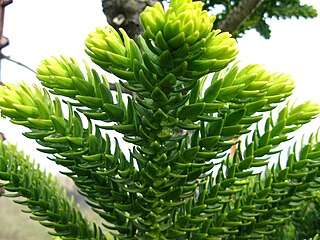
The smallfin gulper shark is a medium-sized deepwater dogfish in the family Centrophoridae.

Cupaniopsis is a genus of about 67 species of trees and shrubs of the soapberry family, Sapindaceae. They grow naturally in New Guinea, New Caledonia, Australia, Torres Strait Islands, Fiji, Samoa, Sulawesi, Micronesia. Many species have been threatened with extinction globally or nationally, with official recognition by the International Union for Conservation of Nature (IUCN) and several national and state governments.

The New Caledonian lorikeet is a potentially extinct lorikeet endemic to the Melanesian island of New Caledonia.

The crow honeyeater is a very large honeyeater endemic to humid forests in New Caledonia in the South Pacific.
The New Caledonian wattled bat is a species of vesper bat, family Vespertilionidae. It is found only in New Caledonia.
Agathis montana, the Mount Panié kauri, is a species of conifer in the family Araucariaceae that is endemic to the higher elevations of Mont Panié in New Caledonia. The Latin specific epithet montana refers to mountains or coming from mountains. Its native name is "Dayu Biik" in Nemi and Fwâi. It is a long-living species, with one recently dead tree of 80 m estimated to be 1,100–1,300 years old based on 14C dating. It is threatened by feral pigs, Phytophthora disease, bark beetles and climate change.

Araucaria laubenfelsii is a species of conifer in the family Araucariaceae. It is found only on Grande Terre, the main island of New Caledonia, mainly on the southern mountains Mont Mou, Mont des Sources, Mont Dzumac and Mont Dou, though smaller populations also exist on Mont Kaala and Mont Canala in the north. It is one of the larger of New Caledonia's native araucaria species, sometimes reaching up to 50 meters in height in emergent rainforest specimens, and potentially living for as long as 500 years or more. As with other New Caledonian Araucaria species, Araucaria laubenfelsii is threatened by habitat loss, though southern populations at least are considered to be healthy and it is not currently considered vulnerable or endangered. A population genetic study suggested that A. laubenfelsii is doubtfully distinct from the more widespread A. montana.

Araucaria subulata is a species of conifer in the family Araucariaceae. It is found only in New Caledonia, with scattered populations present across the central and southern mountain regions of the main island Grande Terre, especially on Mont Dzumac and Mont des Sources. It is one of the tallest of New Caledonia's endemic araucaria species, reaching up to 50 meters in height. Young trees, like the one in the picture, show simaler growth habits to the Norfolk Island Pine. It is threatened by habitat loss as with all of New Caledonia's araucaria trees, but populations of Araucaria subulata are currently considered to be stable and it was not found to be threatened or endangered when most recently assessed.
Clinosperma macrocarpa is a species of palm tree known from a single population at around 500 metres (1,600 ft) altitude on Mont Panié, New Caledonia. It was described as the only species in the genus Lavoixia, but has since been moved to genus Clinosperma. It is listed as critically endangered on the IUCN Red List.
Saribus jeanneneyi is a very rare species of palm tree in the genus Saribus. It is endemic to southern New Caledonia, where only one mature specimen, surrounded by a few seedlings, survived in its native habitat as of 1997. The cause of its rarity in the wild is because its meristem is edible.

The cloven-feathered dove is a species of bird in the family Columbidae. It is monotypic within the genus Drepanoptila, but this genus is possibly better merged into Ptilinopus. The cloven-feathered dove is endemic to New Caledonia where found in forest and Melaleuca savanna at altitudes up to 1,000 m (3,300 ft).

The silky cuscus is a species of marsupial in the family Phalangeridae. It is found in Indonesia and Papua New Guinea.
Kermadecia pronyensis is a species of plant in the family Proteaceae. It is endemic to New Caledonia. It is threatened by habitat loss.
Virotia neurophylla is a species of plant in the family Proteaceae. It is endemic to New Caledonia. It is threatened by habitat loss. It has recently been transferred to the genus Virotia, which is also endemic to New Caledonia.
Stenocarpus heterophyllus is a species of plant in the family Proteaceae. It is endemic to New Caledonia. It is threatened by habitat loss.
Zygogynum cristatum is a species of plant in the family Winteraceae. It is endemic to New Caledonia and is threatened by habitat loss.

Zygogynum is a genus of plant in family Winteraceae. 19 species are native to New Caledonia, and are pollinated primarily by beetles and moths. Other species are native to New Guinea, the Bismarck Archipelago, the Solomon Islands, Lord Howe Island, and Queensland.
Zygogynum oligostigma is a species of plant in the family Winteraceae. It is endemic to New Caledonia. It is threatened by habitat loss.

The New Caledonia blossom bat is an uncommon species of megabat in the family Pteropodidae. The species lives in caves in northern New Caledonia, and forms colonies of up to 300.
Paniegekko is a monotypic genus of geckos in the family Diplodactylidae, containing the species Paniegekko madjo. It is endemic to humid montane forests on Mont Ignambi and Mont Panié in the Panié massif of New Caledonia. It was once considered a species of Bavayia, a similar genus of arboreal geckos. Paniegekko madjo is endangered, owing to predation by introduced rodents and cats combined with habitat degradation by wildfires and introduced pigs and deer. It has not been observed since 1998.










